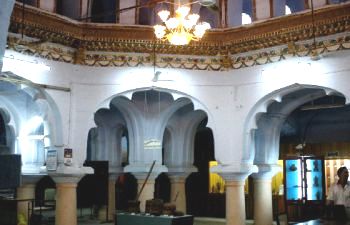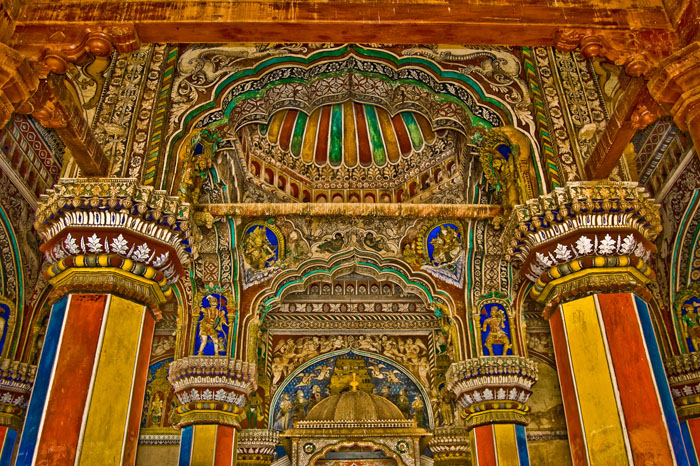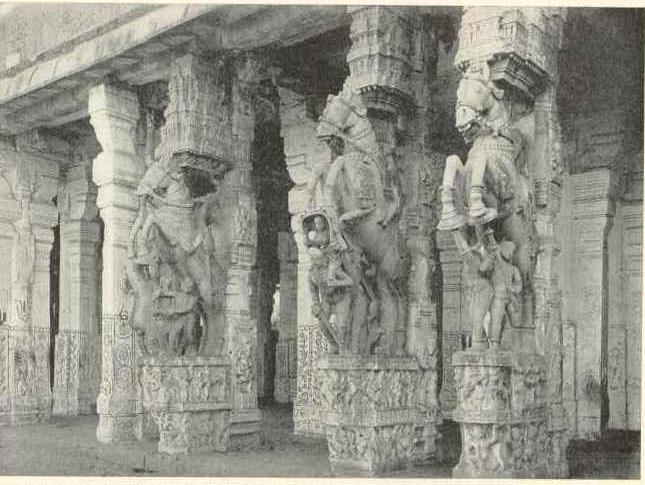|
Vijaya Raghava Nayak
Vijaya Raghava Nayak (also Vijayarāghava Nāyaka, 1590s–1673) was the fourth and last king of Sevappa Nayak's line. He ruled from 1634 to 1673. In 1673, Vijaya Raghava Nayak was defeated in battle by the Madurai Nayak king Chokkanatha Nayak who captured and beheaded him. Personal life Vijaya Raghava Nayak was the eldest son of Raghunatha Nayak Raghunatha Nayak was the most powerful king of the Thanjavur Nayak Dynasty. He was the third ruler of Thanjavur, southern India, from the Nayak dynasty. He belongs to Balija caste. He ruled from 1600 to 1634 and is noted for the attainments of T .... He held the titles "Mannaru Dasa" and "Sahitya Raya". He ascended the throne in 1634 on the death of his father and predecessor. He had son called Sengamaladas who ruled thanjavur under the help of Maratha king Ekoji, then he was chased away from his kingdom. Patronage of art and music Like his father Raghunatha Nayak, Vijaya Raghava Nayak was also a patron of art and music. He co ... [...More Info...] [...Related Items...] OR: [Wikipedia] [Google] [Baidu] |
Sevappa Nayak
Sevappa Nayaka was a Nayaka (governor) of Thanjavur under the Vijayanagara Empire from 1532 to 1560. Ancestry and personal life Sevappa was the successor of his father Timmappa Nayaka, also known as Timmabuban and Timmabhupati, the Viceroy of northern Arcot and his wife Bayyambika. The family hailed from Nedungundram near Tiruvannamalai. Timmappa Nayaka served Emperor Krishnadevaraya in the high honoured position of ''Vāśal'' i.e. door-keeper. He married Murtimamba, the sister of princess Tirumalamba and the sister-in-law of Emperor Achyuta Deva Raya. The duo had a son in Achyutappa who is named in the honour of their emperor. The Telugu histories ''Tanjavuri Andhra Rajula Charitramu'' and ''Tanjavuri Vari Charitram'' claim that Sevappa was awarded Thanjavur province as stridhana. However, this opinion is not universally held by scholars. Campaigns Sevappa was a loyal vassal of the Vijayanagara Emperors and assisted them in their campaigns. Sevappa was a dalavay f ... [...More Info...] [...Related Items...] OR: [Wikipedia] [Google] [Baidu] |
Madurai Nayak
The Madurai Nayakas were a Telugu dynasty * * * * * who ruled most of modern-day Tamil Nadu, India, with Madurai as their capital. The Madurai Nayaks had their origins in the Balija warrior clans of present-day Andhra Pradesh. * * * * * * * * * * * * * * * * * * The Nayak reign which lasted for over two centuries from around 1529 to 1736 was noted for its achievements in arts, cultural and administrative reforms, revitalization of temples previously ransacked by the Delhi Sultans, and the inauguration of a unique architectural style. It was founded by Vishwanatha Nayaka. The dynasty consisted of 13 rulers, of whom nine were kings, two were queens, and two were joint-kings. The most notable among them were king Tirumala Nayaka and queen Rani Mangammal. Foreign trade was conducted mainly with the Dutch and the Portuguese, as the British and the French had not yet made inroads into the region. History Origins The Dalavay Agraharam Plates of Venkata I, ment ... [...More Info...] [...Related Items...] OR: [Wikipedia] [Google] [Baidu] |
Chokkanatha Nayak
Chokkanatha Nayak (1662—1682) succeeded his father Muttu Alkadri Nayak, as the ruler of the Madurai Nayak dynasty The Madurai Nayakas were a Telugu people, Telugu dynasty * * * * * who ruled most of modern-day Tamil Nadu, India, with Madurai as their capital. The Madurai Nayaks had their origins in the Balija warrior clans of present-day Andhra Pradesh. * ..., when he was sixteen years old. References {{reflist Madurai nayaks Telugu people Telugu monarchs ... [...More Info...] [...Related Items...] OR: [Wikipedia] [Google] [Baidu] |
Raghunatha Nayak
Raghunatha Nayak was the most powerful king of the Thanjavur Nayak Dynasty. He was the third ruler of Thanjavur, southern India, from the Nayak dynasty. He belongs to Balija caste. He ruled from 1600 to 1634 and is noted for the attainments of Thanjavur in literature, art, and Carnatic music. Early life Raghunatha Nayak was the eldest son of Achuthappa Nayak and was born after intense penance by his father. The '' Raghunathabhyudayam'' and ''Sahityanatyakara'' give a detailed account of his childhood. As a boy, Raghunatha learned the shastras, the art of warfare and administration. He had multiple queens, chiefly Kalavati referred to in the ''Raghunathabhyudayam'' as Pattampurani. Ramabhadramba, who wrote a history of the Thanjavur Nayak dynasty, was one of his concubines. Wars With Golconda Sultanate In his early days, Raghunatha won acclaim fighting the Golconda Sultanate. He ascended the throne in 1600, ruled with his father from 1600 to 1614, and as sole monarch from ... [...More Info...] [...Related Items...] OR: [Wikipedia] [Google] [Baidu] |
Ekoji
Vyankojirajah Bhonsle (born 1632) or Ekoji I Bhonsle was the younger half-brother of Chhatrapati Shivaji Maharaj and founder of Maratha rule in Thanjavur in modern day Tamil Nadu. He was the progenitor of the junior branch (cadet branch) of the Bhonsle family which ruled Thanjavur until the formal annexation of the kingdom by the British East India Company in 1855. Early career Venkoji was the younger son of Shahaji, a military commander in service of the Sultan of Bijapur through his younger wife Tukabai Mohite. He succeeded to the Karnataka portion of Shahaji's jagir, that is Bengaluru and Thanjavur. Conquest of Thanjavur In 1673, the Nayak of Madurai invaded the kingdom of Thanjavur under the rule of the Thanjavur Nayaks and drove away the ruler. He then proceeded to place his younger brother Alagiri Nayak on the throne of Thanjavur. This was resented by Rayasam Venkanna, a high-ranking official in the court of Thanjavur who supported the cause of Chengamala Dasu, t ... [...More Info...] [...Related Items...] OR: [Wikipedia] [Google] [Baidu] |
The Hindu
''The Hindu'' is an Indian English-language daily newspaper owned by The Hindu Group, headquartered in Chennai, Tamil Nadu. It was founded as a weekly publication in 1878 by the Triplicane Six, becoming a daily in 1889. It is one of the Indian Newspaper of record, newspapers of record. , ''The Hindu'' is published from 21 locations across 11 states of India. ''The Hindu'' has been a family-owned newspaper since 1905, when it was purchased by S. Kasturi Ranga Iyengar from the original founders. It is now jointly owned by Iyengar's descendants, referred to as the "Kasturi family", who serve as the directors of the holding company. Except for a period of around two years, when Siddharth Varadarajan, S. Varadarajan held the editorship of the newspaper, senior editorial positions of the paper have always been held by members of the original Iyengar family or by those appointed by them under their direction. In June 2023, the former chairperson of the group, Malini Parthasarathy, w ... [...More Info...] [...Related Items...] OR: [Wikipedia] [Google] [Baidu] |
Nayak Of Madurai
The Madurai Nayakas were a Telugu dynasty * * * * * who ruled most of modern-day Tamil Nadu, India, with Madurai as their capital. The Madurai Nayaks had their origins in the Balija warrior clans of present-day Andhra Pradesh. * * * * * * * * * * * * * * * * * * The Nayak reign which lasted for over two centuries from around 1529 to 1736 was noted for its achievements in arts, cultural and administrative reforms, revitalization of temples previously ransacked by the Delhi Sultans, and the inauguration of a unique architectural style. It was founded by Vishwanatha Nayaka. The dynasty consisted of 13 rulers, of whom nine were kings, two were queens, and two were joint-kings. The most notable among them were king Tirumala Nayaka and queen Rani Mangammal. Foreign trade was conducted mainly with the Dutch and the Portuguese, as the British and the French had not yet made inroads into the region. History Origins The Dalavay Agraharam Plates of Venkata I, ment ... [...More Info...] [...Related Items...] OR: [Wikipedia] [Google] [Baidu] |
Siege Of Trichinopoly (1660)
The siege of Trichinopoly in 1660 was a conflict during Chokkanatha Nayak's reign aided by the treacherous general Lingama Nayak, a Bijapuri army led by Shahaji laid siege to the fort with a combined force of 12,000 infantry and 7,000 cavalry. The defenders faced challenges from both the besiegers and conspirators within their ranks. Chokkanatha Nayak's vigilance exposed plots, leading to the execution of traitors and the reorganization of his administration. This swift action turned the tide forcing the retreat of the Bijapuri forces to Gingee. Background Upon ascending the throne, Chokkanatha Nayak declared war against Bijapur Sultanate aiming to oust its forces from Gingee restore the Nayaks of the region, and revive the prestige of the Vijayanagara Empire. Entrusting General Linganna Nayaka with a vast cavalry force of 40,000, Chokkanatha Nayak launched an offensive against Sagosi (Shahaji), the Bijapuri general at Gingee. Despite the military strength, the campaign was marred ... [...More Info...] [...Related Items...] OR: [Wikipedia] [Google] [Baidu] |
Thanjavur Nayak Kingdom
The Thanjavur Nayak dynasty (or Thanjavur Nayak kingdom) were the rulers of Thanjavur in the 15th and 17th centuries founded by Sevappa Nayaka. The Nayaks, who were Telugu Balijas,* * * * * * * * * were originally appointed as provincial governors by the Vijayanagara Emperor in the 15th century, who divided the territory into Nayak kingdoms which were Madurai, Thanjavur and Gingee. In the mid-15th century they became an independent kingdom, although they continued their alliance with the Vijayanagara Empire. The Thanjavur Nayaks were notable for their patronage of literature and the arts. Origins of Nayak rule With the end of the Chola Empire in 1279, Thanjavur was ruled by a branch of Chola dynasty, until the Vijayanagara Empire conquered all of southern India by the late 14th century. In 1532 CE, Achyuta Deva Raya, the brother and successor of Krishna Deva Raya of Vijayanagara Empire, granted Sevappa Nayak, the governor of Thanjavur, the permission to esta ... [...More Info...] [...Related Items...] OR: [Wikipedia] [Google] [Baidu] |
Alagiri Nayak
Alagiri Nayak was the younger brother of the Madurai Nayak king Chokkanatha Nayak and the last Nayak king of Thanjavur. In 1675, Thanjavur was conquered by Ekoji I, the half-brother of Shivaji who founded the Thanjavur Maratha kingdom The Thanjavur Maratha kingdom ruled by the Bhonsle dynasty, Bhonsle dynasty was a principality of Tamil Nadu between the 17th and 19th centuries. Their native language was Thanjavur Marathi dialect, Thanjavur Marathi. Vyankoji Bhosale was the .... Kings in Asia Madurai Nayak dynasty Thanjavur Maratha kingdom {{Asia-royal-stub ... [...More Info...] [...Related Items...] OR: [Wikipedia] [Google] [Baidu] |
1590s Births
Year 159 ( CLIX) was a common year starting on Sunday of the Julian calendar. At the time in Roman territories, it was known as the Year of the Consulship of Quintillus and Priscus (or, less frequently, year 912 ''Ab urbe condita''). The denomination 159 for this year has been used since the early medieval period, when the Anno Domini calendar era became the prevalent method in Europe for naming years. Events By place India * In India, the reign of Shivashri Satakarni, as King Satavahana of Andhra, begins. Births * December 30 – Lady Bian, wife of Cao Cao (d. 230) * Annia Aurelia Fadilla, daughter of Marcus Aurelius * Gordian I, Roman emperor (d. 238) * Lu Zhi, Chinese general (d. 192) Deaths * Liang Ji, Chinese general and regent In a monarchy, a regent () is a person appointed to govern a state because the actual monarch is a minor, absent, incapacitated or unable to discharge their powers and duties, or the throne is vacant and a new monarch ... [...More Info...] [...Related Items...] OR: [Wikipedia] [Google] [Baidu] |



